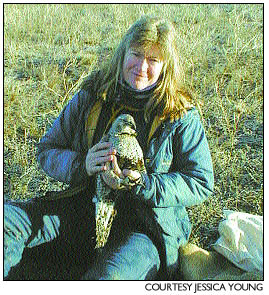|
Dec. 9, 2000 By Janelle Holden
Genetic researchers have scientifically proven what has become common knowledge about the Gunnison sage grouse: It is a distinct and separate species of bird. The researchersí peer-reviewed findings will be published in the December issue of the Wilson Bulletin, a scientific quarterly published by the Wilson Ornithological Society. The publication will include a discussion of the genetic research conducted by researchers from the U.S. Geological Survey, University of Denver, Western State College of Colorado, Colorado Division of Wildlife and Colorado State University. The study was funded by the DOW. Historically, scientists classified the Gunnison sage grouse as the same species as the greater sage grouse. But over the years, differences in body size and unique plumage and behaviors have led scientists to question this kinship. The scientists confirmed the new species by conducting a detailed DNA analysis of the two groups of grouse. "Compiling the evidence needed to formally designate a new species is no easy task," said Jessica Young, a professor of biology at Western State College. Young led the studies with DOW researcher Clait Braun. Young has researched the Gunnison sage grouse since 1988, and is quick to acknowledge the help she has received from her colleagues and undergraduate students over the years. She said the next step in protecting the bird is implementing all of the current county, state, and federal conservation plans. The Gunnison sage grouse is found in the sagebrush ecosystem of southwestern Colorado and southeastern Utah, and the greater sage grouse is found in northern Colorado and throughout 11 Western states and two Canadian provinces. The researchers used DNA markers to determine whether the two species had interbred. Sara Oyler-McCance, a conservation geneticist with the U.S. Geological Survey, said the two groups of sage grouse were too distantly related to be considered the same species, and interbreeding had not occurred. Evidence of reproductive isolation is one criterion for species designations. The studies also confirmed that most populations of the Gunnison sage grouse are geographically and genetically isolated from each other. This discovery means that the two species have low genetic diversity, a factor that can contribute to a speciesí decline or extinction. In fact, the study could be an important step in the birdís listing as an endangered species. In January 2000, the U.S. Fish and Wildlife Service was petitioned by the American Lands Alliance and a coalition of conservation and scientific organizations to list the Gunnison sage grouse as a federally endangered species. The group filed a lawsuit on Sept. 29 to force the Fish and Wildlife Service to issue a 90-day finding, but none has been made so far. The group was concerned that the species is at risk of extinction because of habitat loss, fragmentation and degradation. Since then, federal, state and local groups have developed locally supported conservation plnas for the grouse. Currently, these small grouse are restricted to isolated populations in Colorado and Utah with a total population of less than 5,000. Some populations are quite small, with fewer than 150 breeding birds, and several former populations have died off since 1980. Although no past population numbers are known, scientists have used historical documents and interviews to estimate that Gunnison sage-grouse populations were higher than current numbers, and that the species were found over a much larger geographic area. Gary Thrash, a BLM multi-resources staff supervisor from Durango, said the study will not require an initial change to sage-grouse management plans. The BLM, and other groups have worked with landowners on the Western Slope for several years to implement conservation plans and preclude the species listing. If the grouse ends up being listed, that could change, he explained. The closest populations of Gunnison sage grouse are located near Dove Creek and in the Dry Creek Basin, totaling close to 150 birds in each area. Thrash said the grouse species have a high rate of mortality, and are easy prey for coyotes and raptors, especially in piŮon-juniper habitat that provides raptor perches. Formally, the new species will now be known as Centrocercus minimus because of its relatively small size, but will remain for many the Gunnison sage grouse, a name picked for the area in Colorado it was discovered. The Gunnison sage grouse is known for its impressive spring seasonal ritual where the males gather together to impress discerning females with their booming from bright yellow air sacs and their strutting and hopeful dances. The females choose a lucky suitor, and then are left to raise their young through the mountain summer and fall. |
||
|
Copyright © 2000 the Cortez Journal.
All rights reserved. |
